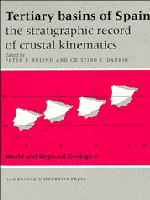Book contents
- Frontmatter
- Contents
- List of contributors
- Preface
- Dedication to Professor Oriol Riba IArderiu
- Memorial, Etienne Moissenet 1941–1994
- PART G GENERAL
- PART E EAST
- E1 Geological setting of the Tertiary basins of Northeast Spain
- E2 The lithosphere of the Valencia Trough: a brief review
- E3 Depositional sequences in the Gulf of Valencia Tertiary basin
- E4 Neogene basins in the Eastern Iberian Range
- E5 The Tertiary of the Iberian margin of the Ebro basin: sequence stratigraphy
- E6 The Tertiary of the Iberian margin of the Ebro basin: paleogeography and tectonic control
- E7 Stratigraphy of Paleogene deposits in the SE margin of the Catalan basin (St. Feliu de Codines – St. Llorenç del Munt sector, NE Ebro basin)
- E8 Onshore Neogene record in NE Spain: Vallès–Penedès and El Camp half-grabens (NW Mediterranean)
- E9 The Paleogene basin of the Eastern Pyrenees
- E10 The Neogene Cerdanya and Seu d'Urgell intramontane basins (Eastern Pyrenees)
- E11 Eocene-Oligocene thrusting and basin configuration in the eastern and central Pyrenees (Spain)
- E12 The Late Eocene–Early Oligocene deposits of the NE Ebro Basin, West of the Segre River
- E13 Chronology of Eocene foreland basin evolution along the western oblique margin of the South–Central Pyrenees
- E14 Evolution of the Jaca piggyback basin and emergence of the External Sierra, southern Pyrenees
- E15 Long-lived fluvial palaeovalleys sited on structural lineaments in the Tertiary of the Spanish Pyrenees
- E16 Evolution of the central part of the northern Ebro basin margin, as indicated by its Tertiary fluvial sedimentary infill
- E17 The Rioja Area (westernmost Ebro basin): a ramp valley with neighbouring piggybacks
- PART W WEST
- PART C CENTRE
- PART S SOUTH
- Index
E6 - The Tertiary of the Iberian margin of the Ebro basin: paleogeography and tectonic control
Published online by Cambridge University Press: 04 August 2010
- Frontmatter
- Contents
- List of contributors
- Preface
- Dedication to Professor Oriol Riba IArderiu
- Memorial, Etienne Moissenet 1941–1994
- PART G GENERAL
- PART E EAST
- E1 Geological setting of the Tertiary basins of Northeast Spain
- E2 The lithosphere of the Valencia Trough: a brief review
- E3 Depositional sequences in the Gulf of Valencia Tertiary basin
- E4 Neogene basins in the Eastern Iberian Range
- E5 The Tertiary of the Iberian margin of the Ebro basin: sequence stratigraphy
- E6 The Tertiary of the Iberian margin of the Ebro basin: paleogeography and tectonic control
- E7 Stratigraphy of Paleogene deposits in the SE margin of the Catalan basin (St. Feliu de Codines – St. Llorenç del Munt sector, NE Ebro basin)
- E8 Onshore Neogene record in NE Spain: Vallès–Penedès and El Camp half-grabens (NW Mediterranean)
- E9 The Paleogene basin of the Eastern Pyrenees
- E10 The Neogene Cerdanya and Seu d'Urgell intramontane basins (Eastern Pyrenees)
- E11 Eocene-Oligocene thrusting and basin configuration in the eastern and central Pyrenees (Spain)
- E12 The Late Eocene–Early Oligocene deposits of the NE Ebro Basin, West of the Segre River
- E13 Chronology of Eocene foreland basin evolution along the western oblique margin of the South–Central Pyrenees
- E14 Evolution of the Jaca piggyback basin and emergence of the External Sierra, southern Pyrenees
- E15 Long-lived fluvial palaeovalleys sited on structural lineaments in the Tertiary of the Spanish Pyrenees
- E16 Evolution of the central part of the northern Ebro basin margin, as indicated by its Tertiary fluvial sedimentary infill
- E17 The Rioja Area (westernmost Ebro basin): a ramp valley with neighbouring piggybacks
- PART W WEST
- PART C CENTRE
- PART S SOUTH
- Index
Summary
Abstract
The major structures of the Iberian margin of the Ebro basin are described, and their regional kinematics are discussed. Two types of alluvial fan system are distinguished. The paleogeographic and tectonic evolution of the margin is analysed in terms of the eight tecto-sedimentary units defined in the previous chapter. Rates of sedimentation averaging 10 cm/1000 years for the Paleogene dropped to 7 cm/1000 years for the Neogene.
Introduction
The sedimentation of the Tertiary of the Iberian margin of the Ebro basin was mainly controlled by tectonic activity. Tectonic activity controlled the horizontal and vertical evolution of the sedimentary fill (see Chapter E5), the geographic location and orientation of the thresholds and the depositional areas, the extent and relief of the source areas, and also certain aspects of the facies of the deposits.
Because of the controlling importance of tectonic activity, we start this chapter with an outline of the main tectonic structures that were active under general tectonic compression throughout the Tertiary. Some of these structures probably originated as strikeslip faults during the Late Paleozoic, and then controlled the Mesozoic sedimentary history of the Iberian Range (Alvaro et al., 1979).
We first describe the most important structures (Fig. 1).
In the western sector, to the NW of the Queiles river, the major structures (Muñoz, 1992) are the thrust front of the Sierra de Cameros–Demanda, the NE–SW prolongation of the Odemira–Avila basement-cutting fault, and the Arnedo, Baños de Río Tobía and Najera monoclinal folds.
- Type
- Chapter
- Information
- Tertiary Basins of SpainThe Stratigraphic Record of Crustal Kinematics, pp. 83 - 88Publisher: Cambridge University PressPrint publication year: 1996
- 8
- Cited by



